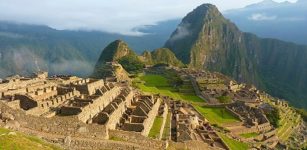Dracula: Cruel, Ruthless And Bloodthirsty Ruler But Not A Vampire
A. Sutherland - AncientPages.com - No doubt, the most famous and intriguing Romanian figure in both history and fiction is Vlad Țepeș (Dracula). Behind Dracula's renowned name is also the extraordinary life and times of the evil Romanian ruler from 1431 to 1476. His nickname is the Impaler.
Vlad used severe methods to restore order in a lawless state. He also had the courage to drive the occupation force, the Ottomans out of the country. But Vlad had a dark side… too.
He was regarded with great fear in many regions of Europe and Asia in the fifteenth century and strived to equal by many later rulers like, for example, Ivan the Terrible; Dracula did, in fact, exist.
He was also highly honored by his fellow citizens and is still even today.
However, he was not a bloodthirsty vampire but a Prince in Wallachia, a part of present-day southern Romania.
Vlad lived in Romania among many rulers and historical figures, surrounded by prejudices and controversies in the atmosphere of betrayal, conquest, and imprisonment.
As the author writes in "Captivating History; History of Romania, "the greatness of historic individuals cannot be measured through the prism of the modern age. To fully understand the actions and motivations of Vlad Tepes, Stephen the Great, and Michael the Brave, we have to understand that Romania was positioned between the Ottoman Empire and Europe, between the traditional East and the modern West. Just as the world was torn between the great powers, so were the rulers of Romania.."
Vlad Tepes (the Impaler)
His real name was Vlad III, but he was often called Dracula. Romania is full of ancient tales of the supernatural and legends of the unexplained, which have long influenced our imagination.
The Irish author Bram Stoker likely borrowed Vlad's name for his Transylvanian count in the book "Dracula" from 1897. We must remember that 'Dracula' is translated in Gaelic as Drac Ullah, which means 'bad blood.'
Vlad lived between 1431 and 1476 and is regarded as a national hero in his home country. He was considered a brutal and yet fair ruler.
During the 15th century, there was a struggle to obtain control of Wallachia, a region of the Balkans (Romania) that lay directly between the two powerful forces of Hungary and the Ottoman Empire. The power of the Ottomans seemed unstoppable.
Vlad used severe methods to restore order in a lawless state. He also dared to drive the occupation force, the Ottomans, out of the country. But Vlad had a dark side, too. He was delighted in torture and executions.
He was famous for slowly driving a pole through the bodies of his enemies while they were still alive. Vlad was a ruthless man, and his "methods" were brutal. Impalement was and is one of the most gruesome ways of dying.
His enemies feared Dracula, and he was called Tepes, meaning the Impaler.
It often took hours, sometimes even days, before the poor victim died on the pole. Later, the pole and the victim's body were publicly displayed. This horrifying sight was meant to serve as a warning to all Ottomans as well as different types of criminals, like thieves, murderers, and others.
The origin of the name Dracula has yet to be entirely confirmed. "Drac" means "devil" in the Romanian language and the ending "-uela" means "son of." We can assume that Vlad's nickname was "Son of the Devil."
Still, we must remember another essential aspect related to the origin of Vlad's name.
In 1431, Vlad's father was a member of the Order of the Dragon, a secret order of knights meant to protect the royal family from the invading Ottoman Turks.
The dragon was considered a symbol of the devil. Therefore, Vlad's name means "Son of the Dragon" or "Son of the Devil."
It is unknown why Bram Stoker used the name Dracula in his book, but there are two theories.
In 1890, Stoker borrowed the book "An Account of the Principalities of Wallachia and Moldavia," written 1820 by William Wilkinson. This book contains many descriptions of Dracula's life. Perhaps Stoker used this book as a source and inspiration for his novel.
Another possibility is that Stoker learned about Dracula through his friend Professor Arminius Vambery, whom he visited on several occasions in Budapest. Stoker mixed the history of Dracula's life with folktales of vampires, resulting in a classical book that is popular until today.
Dracula was a cruel, ruthless, and bloodthirsty ruler, but he was not a vampire. He is considered a national symbol of Romania's fight for independence against the Ottomans.
Written by A. Sutherland - AncientPages.com Senior Staff Writer
Updated on March 31, 2024
Copyright © AncientPages.com All rights reserved. This material may not be published, broadcast, rewritten or redistributed in whole or part without the express written permission of AncientPages.com
Expand for referencesReferences:
Keith Hitchins, A Concise History of Romania
Raymond T. McNally (Author), Radu R Florescu (Author), Dracula, Prince of Many Faces, 1990
Captivating History, History of Romania
More From Ancient Pages
-
 Archaeologists Search For The Tomb Of Biblical Joshua At Khirbet Tibnah
Archaeology | Aug 5, 2022
Archaeologists Search For The Tomb Of Biblical Joshua At Khirbet Tibnah
Archaeology | Aug 5, 2022 -
 On This Day In History: Battle of Devil’s Hole Was Fought – On Sep 14, 1763
News | Sep 14, 2016
On This Day In History: Battle of Devil’s Hole Was Fought – On Sep 14, 1763
News | Sep 14, 2016 -
 Is The Hashtag World’s Oldest Symbol And First Communication Attempt?
Ancient Symbols | Apr 27, 2018
Is The Hashtag World’s Oldest Symbol And First Communication Attempt?
Ancient Symbols | Apr 27, 2018 -
 Ullikummi – Genderless, Blind, Deaf Rock Monster Created For Strategic Purposes In Beliefs Of Hurrian People
Featured Stories | Feb 26, 2025
Ullikummi – Genderless, Blind, Deaf Rock Monster Created For Strategic Purposes In Beliefs Of Hurrian People
Featured Stories | Feb 26, 2025 -
 82 Mysterious 3,000-Year-Old Pits Discovered In Sweden – Bronze Age Cooking Pits And Ancient Ceremonial Center?
Archaeology | Jun 13, 2017
82 Mysterious 3,000-Year-Old Pits Discovered In Sweden – Bronze Age Cooking Pits And Ancient Ceremonial Center?
Archaeology | Jun 13, 2017 -
 Mysterious Greyfriars Kirkyard: A Cemetery In Edinburgh With Dark And Spooky History
Featured Stories | Sep 16, 2016
Mysterious Greyfriars Kirkyard: A Cemetery In Edinburgh With Dark And Spooky History
Featured Stories | Sep 16, 2016 -
 Unas (Unis): First Pharaoh Who Decorated His Burial Chamber With Pyramid Texts
Featured Stories | Jun 3, 2021
Unas (Unis): First Pharaoh Who Decorated His Burial Chamber With Pyramid Texts
Featured Stories | Jun 3, 2021 -
 Vettuvan Koil Temple Spectacular Monolith Dedicated To Lord Shiva And Built By Pandya Dynasty
Featured Stories | May 25, 2021
Vettuvan Koil Temple Spectacular Monolith Dedicated To Lord Shiva And Built By Pandya Dynasty
Featured Stories | May 25, 2021 -
 Mysterious Object In Asuka – The Place Of ‘Flying Birds’
Civilizations | Aug 11, 2018
Mysterious Object In Asuka – The Place Of ‘Flying Birds’
Civilizations | Aug 11, 2018 -
 Chaneques: Mischievous Legendary Tricksters In Mexican Folklore
Featured Stories | Apr 14, 2020
Chaneques: Mischievous Legendary Tricksters In Mexican Folklore
Featured Stories | Apr 14, 2020 -
 Large Mysterious 2,000-Year-Old Structure Discovered At The Center Of A Military Training Area In Israel
Archaeology | Dec 3, 2017
Large Mysterious 2,000-Year-Old Structure Discovered At The Center Of A Military Training Area In Israel
Archaeology | Dec 3, 2017 -
 4,000-Year-Old Tomb Of Titi Nab Fu, Pharaoh’s Doctor and ‘Magician’ Unearthed In Saqqara
Archaeology | Jan 8, 2025
4,000-Year-Old Tomb Of Titi Nab Fu, Pharaoh’s Doctor and ‘Magician’ Unearthed In Saqqara
Archaeology | Jan 8, 2025 -
 Machu Picchu: Ancient Incan Sanctuary Intentionally Built On Faults
Archaeology | Sep 27, 2019
Machu Picchu: Ancient Incan Sanctuary Intentionally Built On Faults
Archaeology | Sep 27, 2019 -
 Mysterious Shemsu Hor – Followers Of Horus Were Semi-Divine Kings And Keepers Of Sacred Knowledge In Predynastic Egypt
Ancient Mysteries | May 15, 2017
Mysterious Shemsu Hor – Followers Of Horus Were Semi-Divine Kings And Keepers Of Sacred Knowledge In Predynastic Egypt
Ancient Mysteries | May 15, 2017 -
 The Cyclades And Their Mysterious Society Lost In Time
Civilizations | Feb 4, 2016
The Cyclades And Their Mysterious Society Lost In Time
Civilizations | Feb 4, 2016 -
 30,000-Year-Old Hidden Writing Found At Sacsayhuamán Temple Could Re-Write History
Civilizations | Jun 24, 2014
30,000-Year-Old Hidden Writing Found At Sacsayhuamán Temple Could Re-Write History
Civilizations | Jun 24, 2014 -
 Last Of The Giant Camels And Archaic Humans Lived Together In Mongolia Until 27,000 Years Ago
Fossils | Mar 24, 2022
Last Of The Giant Camels And Archaic Humans Lived Together In Mongolia Until 27,000 Years Ago
Fossils | Mar 24, 2022 -
 Ancient Superhighways: 12,000-Year-Old Massive Underground Tunnels From Scotland To Turkey
Featured Stories | Jul 19, 2015
Ancient Superhighways: 12,000-Year-Old Massive Underground Tunnels From Scotland To Turkey
Featured Stories | Jul 19, 2015 -
 On This Day In History: “Man In The Iron Mask” Died In The Bastille, Paris, France – On Nov 19, 1703
News | Nov 19, 2016
On This Day In History: “Man In The Iron Mask” Died In The Bastille, Paris, France – On Nov 19, 1703
News | Nov 19, 2016 -
 Powerful Winds In Ancient Beliefs
Featured Stories | Feb 5, 2024
Powerful Winds In Ancient Beliefs
Featured Stories | Feb 5, 2024

